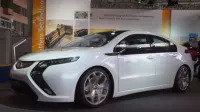Bibendum 2011: Opel Ampera not only looks better than the Chevy Volt, it can do more, too

One of the joys of this year’s Michelin Challenge Bibendum is getting to drive a lot of Europe-only vehicles. In GM’s case, that means the Mervia all-electric hatch and the Opel Ampera, more commonly known stateside as the Chevy Volt’s better-looking twin.
Opel also had two Amperas at Bibendum, one in the ride and drive (short review: it’s a Volt) and one rolling chassis on the stand. The Ampera on the road is a pre-production model that is basically just one step before production. Opel will begin delivering the Ampera at the end of this year. As the “Volt for Europe,” what did GM do to make it more continental? The biggest change that GM made – aside from improving the looks with the new, kick butt fascia, is something called “battery hold.”
When you engage battery hold, you’re telling the drivetrain to keep the battery at its current state of charge. Then when you get to, say, the outskirts of the London congestion charge zone, you can drive using your electrons and not have to pay the congestion fee. We don’t have congestion charges in the U.S., but battery hold certainly sounds like a good idea to have as an option.
We also got to drive the Mervia around the test course. The all-electric Mervia program was not a priority for GM. The three cars GM made were kind of cobbled together from the GM parts bin – it uses the battery from the Volt/Ampera and a motor taken from GM’s hydrogen system – to prove that GM could make a modern electric car and to gain knowledge. The Mervia program is pretty much over with but we still wanted to see what the concoction drove like (short review: it’s an electric hatch). It accelerated and drove fine, but was a bit noisy thanks to the pure prototype/test vehicle status. There was a nice bit of coast when I let my foot off the accelerator, but our driving host told us that there are three levels of regen that the engineers can program in.
The real reason for the Meriva EVs was to work with MeRegioMobil to learn about charging habits and abilities. What happens when people top off their battery with short charges? Can the car tell the utility when the driver wants to leave and let the utility charge the car in a way that works best for the utility (to smooth out the grid, for example)? These were the questions GM wanted answers to, and the information gleaned will be used in other plug-in vehicle programs, especially in regards to battery warranty planning.




